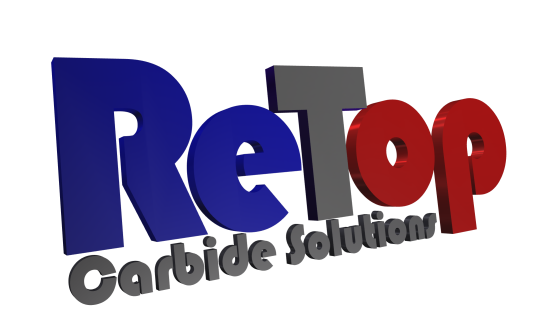Tungsten carbide cutting tools are widely used in manufacturing, metalworking, and construction industries because they are strong, durable, and efficient. But how do these tools affect the environment? In this article, we will explore both the positive and negative environmental impacts of using tungsten carbide cutting tools and offer suggestions for more sustainable usage.
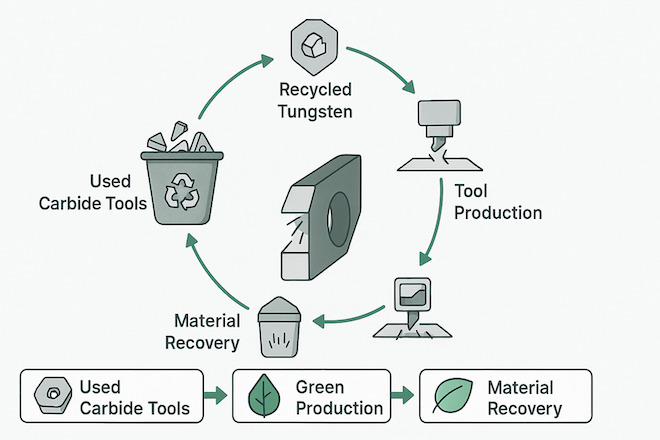
What Is Tungsten Carbide?
Tungsten carbide is a very hard material made by combining tungsten and carbon. It is used to make cutting tools because it lasts much longer than steel tools and can cut very hard materials.
Tungsten carbide cutting tools are commonly used in industries that need high-speed cutting, precise machining, or wear resistance. These tools are often used to make parts in the automotive, aerospace, medical, and electronics industries.
You can learn more about different tungsten carbide tools on www.retopz.com. Visit our product pages for detailed specifications and applications.
Positive Environmental Impacts
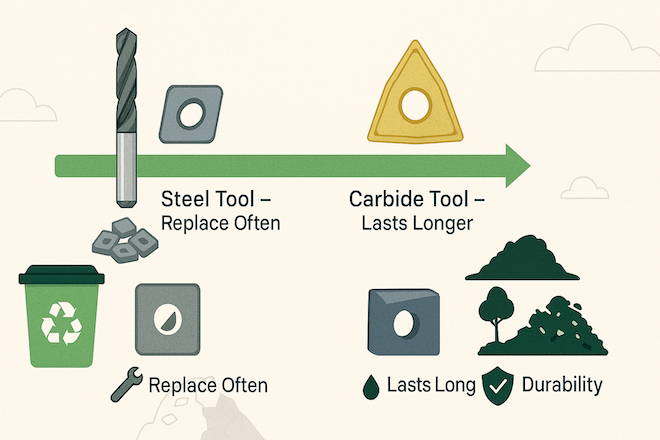
1. Longer Tool Life = Less Waste
One of the biggest advantages of tungsten carbide tools is their long lifespan. Compared to steel tools, they need to be replaced less often. This means:
Less production waste
Fewer tools end up in landfills
Reduced need for frequent shipments
By choosing high-quality carbide tools, companies can reduce the number of tools they throw away, helping the environment.
2. Greater Efficiency Reduces Energy Use
Tungsten carbide tools are sharper and stronger than other tools. Because of this, they can cut materials faster and more accurately. This leads to:
Shorter machine run-time
Less electricity used
Lower carbon emissions
This benefit is especially important in mass production and high-speed machining operations.
3. Recycling and Reuse Potential
Used tungsten carbide tools can be recycled. The tungsten and cobalt inside can be extracted and reused to make new tools. This reduces the need for mining raw materials.
Recycling carbide tools can:
Save natural resources
Lower pollution from mining
Cut down on production energy
At Retop, we support carbide tool recycling and encourage our clients to return worn-out tools.
Negative Environmental Impacts
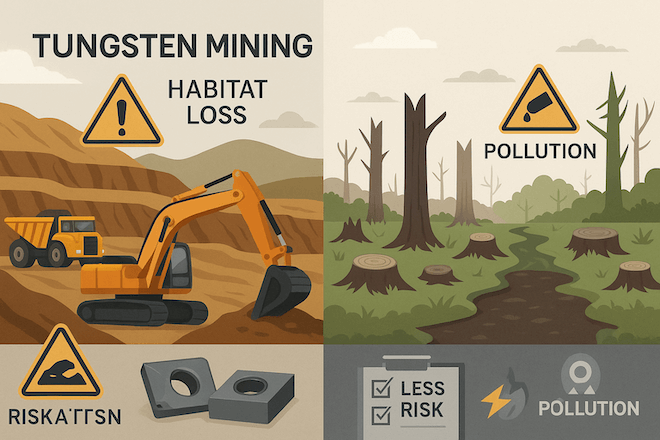
1. Mining and Raw Material Extraction
Tungsten is a rare metal. Mining tungsten can have a serious environmental impact, including:
Deforestation
Water pollution
Habitat destruction
These effects occur in countries where tungsten is mined, such as China, Russia, and Bolivia.
2. High Energy Use in Manufacturing
Making tungsten carbide tools involves high sintering temperatures and pressurized equipment. These processes require:
A lot of energy
High CO₂ emissions
Even though the tools last longer, the energy used in production is high compared to tools made from steel or aluminum.
3. Waste If Not Recycled
If old carbide tools are not recycled, they are often sent to landfills or burned, which wastes valuable metals and pollutes the environment.
How to Make Tungsten Carbide Tools More Eco-Friendly
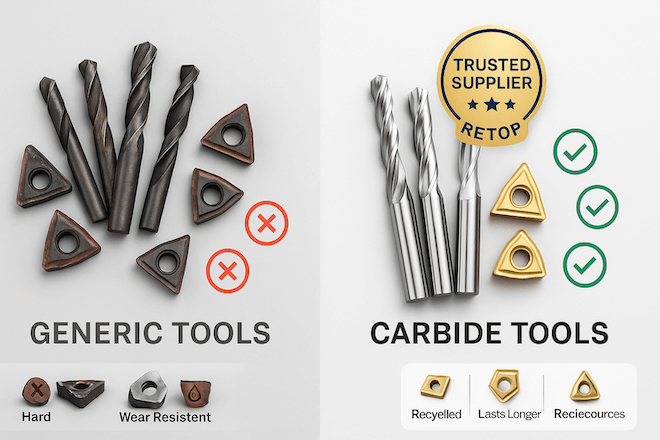
To reduce the environmental impact, manufacturers and users should focus on sustainable practices. Here are some tips:
Choose Quality Tools
High-quality tools perform better and last longer. Buying from trusted suppliers like Retop ensures:
Better tool life
Less frequent replacement
More sustainable use
Regrind and Reuse
Carbide tools can often be resharpened instead of thrown away. This process is called regrinding. It can:
Extend tool life by up to 50–70%
Reduce the number of new tools needed
Save money and materials
Retop provides regrinding services to help our customers reuse their carbide tools.
Recycle Used Tools
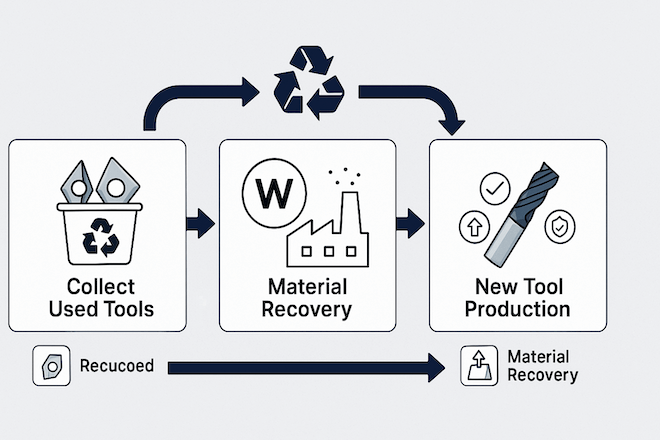
Work with recycling programs that accept used carbide tools. Many companies collect worn-out tools and recover the valuable tungsten inside.
Some benefits of carbide recycling:
Prevents metal waste
Reduces the need for mining
Lowers overall emissions
Comparing Environmental Impact: Carbide vs. Steel Tools
| Feature | Carbide Tools | Steel Tools |
|---|---|---|
| Tool Life | Very long | Short |
| Cutting Efficiency | High | Medium |
| Production Energy Use | High | Low |
| Waste Generation | Low (if recycled) | High |
| Recyclability | Yes | Yes |
| Environmental Impact | Balanced (if reused) | Higher waste & replacement |
Final Thoughts
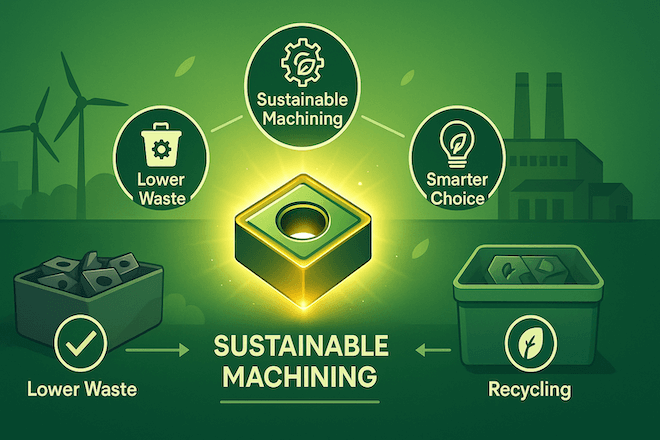
Tungsten carbide cutting tools offer many environmental benefits when used and recycled correctly. While the manufacturing process requires more energy, the longer tool life, recycling potential, and cutting efficiency make them a better choice for sustainable production in the long run.
To make the most eco-friendly choice:
Buy from trusted suppliers like Retop
Choose regrindable and recyclable carbide tools
Follow proper maintenance and recycling methods
For reliable and sustainable tooling solutions, explore our full range at www.retopz.com. We are committed to delivering high-performance tools with environmental responsibility.
